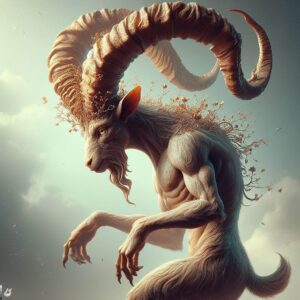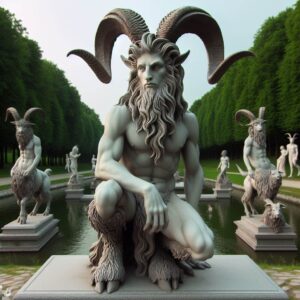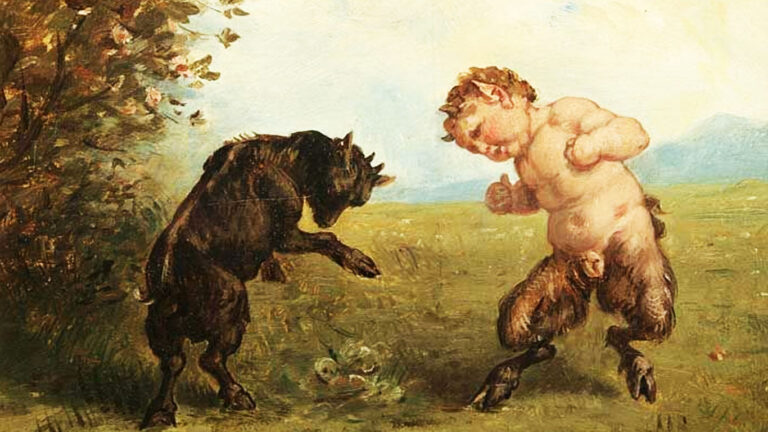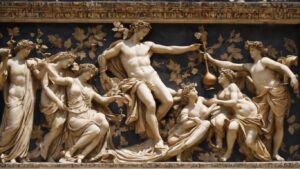Table of Contents
Origins
The term “faun” evokes a mythical creature, a fusion of human and animal features such as goat-like horns, ears, and legs. This concept traces its origins to the annals of ancient mythology and folklore, notably in the traditions of both ancient Rome and Greece.
In Roman mythology, fauns found their association with the rural god Faunus, a deity presiding over nature, fertility, and forests. Faunus, often portrayed as a horned figure with goat legs, imparted his name to the term “faun.”
Greek mythology introduced a parallel creature known as a satyr, akin to the Roman faun. Satyrs, companions of Dionysus, shared traits with fauns, including goat-like features, embodying associations with wine, revelry, and fertility.
The imagery of fauns and satyrs resonated through the corridors of time, persisting in various artistic forms such as Renaissance art and subsequent works inspired by classical mythology. These mythical beings became icons, mischievous figures entwined with the raw and untamed facets of nature.
Originating in ancient myths, the concept of fauns underwent a metamorphosis, adapting to diverse cultures and artistic expressions across the centuries. Modern iterations of fauns find their place in literature, art, and popular culture, showcasing the enduring allure of these enigmatic creatures.
Physical Description

Special Abilities
Within the sacred groves, fauns unveil nature’s profound secrets through extraordinary abilities.
Nature’s Whispers: Fauns, earth’s emissaries, commune with the wild. Silent dialogues unfold between them and woodland creatures, navigating realms with instinctive grace.
Harmony in Melody: Fauns wield magical instruments — flutes and pan pipes — conduits for enchantment. Tunes echo through the woodland, stirring spirits of flora and fauna alike.
Guardians of Fertility: Custodians of cycles, fauns ensure the abundance of harvests. Revered protectors of vital life forces sustaining mortals and denizens alike.
Metamorphic Dance: Fauns shape-shift between human and animal forms, fluidly traversing realms, adapting to the ebb and flow of existence.
Whimsy and Revelry: In moonlit glades, fauns revel in mischievous exploits, imparting whimsy to the forest. Playful antics remind that life’s tapestry is woven with joy.
Sacred Celebrants: Hooves beating a rhythmic cadence, fauns lead woodland festivities. Their presence turns joy into an offering, celebrating life’s enduring cycles.
Guardians of the Enchanted Thicket: Fauns stand vigilant, fierce protectors of enchanted thickets. They ward off intruders, preserving the natural balance and sanctity of woodland domains.
In the enchanting realm of fauns, these mystical beings intertwine destinies with nature’s rhythms, revealing the echoes of celebration in the ancient woods.
Related Characters
In Greek mythology, satyrs emerge as counterparts to Roman fauns, sharing the woodland realm and a hybrid form with human upper bodies and goat-like lower bodies. Aligned with Dionysus, these mischievous and lustful creatures dance through the mythic landscape.
Pan: Nature’s Melodious Guardian
Pan, the Greek god of shepherds and rustic music, mirrors the faun with goat-like legs and horns. This playful deity, guardian of nature’s symphony, perpetuates a mischievous demeanor across the pastoral landscape.
Cernunnos: Celtic Echoes of the Wild
In Celtic mythology, Cernunnos, a horned god, weaves through the tapestry of nature, fertility, and the wild. Though not a faun, Cernunnos shares the essence of horned deities, evoking the untamed forces of the natural world.
Puck’s Pranks in English Lore
In English folklore, Puck, a mischievous sprite, mirrors the playful traits of fauns. While not a direct faun, Puck’s pranks in Shakespearean literature evoke the whimsy and mischief attributed to woodland beings.
The Green Man: Leaves of Fertility
Found in various mythologies, the Green Man, a visage surrounded by leaves, resonates with faun-like associations. Linked to nature, fertility, and the seasons, this figure embodies the cyclical dance of life.
Faunus: The Roman Connection
As previously mentioned, Faunus, the Roman god, embodies faun-like attributes, depicted with goat-like features. He stands as a guardian of fertility, forests, and pastoral landscapes in the Roman pantheon.
Silenus: Dionysus’s Elderly Companion
In Greek mythology, Silenus, an aged satyr and companion of Dionysus, personifies wisdom, intoxication, and revelry. His presence echoes the enduring traits associated with fauns and their connection to the untamed.
Krampus: Alpine Yuletide Enigma
In Alpine folklore, Krampus, a horned figure tied to Christmas, bears a mix of human and animal features. While distinct, Krampus shares a kinship with fauns, embodying mischievous and frightening qualities in festive traditions.
Historical Tapestry

Throughout history, the cultural representation of fauns has woven a rich tapestry, each civilization adding unique threads to the narrative.
In Roman mythology, fauns became entwined with the benevolent spirit of Faunus, a horned deity embodying fertility and nature. These creatures, with goat-like features, were heralds of vitality in the pastoral landscape.
Greek mythology introduced the satyrs, the Hellenic counterparts to Roman fauns. Companions of Dionysus, satyrs mirrored fauns’ playful and mischievous nature, engaging in revelry that celebrated life’s pleasures.
Celtic and Druidic traditions, though not explicitly featuring fauns, incorporated horned deities like Cernunnos, echoing a connection to nature and fertility that resonated across cultures.
During the Renaissance, fauns and satyrs found a revival in art, with masters like Botticelli and Titian depicting their connection to nature in mythological scenes. This artistic renaissance breathed new life into classical themes.
Literature, spanning various periods and cultures, wove fauns into tales of fantasy and symbolism. From C.S. Lewis’s Mr. Tumnus to J.M. Barrie’s Pan, fauns became characters bridging the fantastical and the human.
Modern Echoes
In contemporary times, the cultural resonance of fauns persists, echoing through popular culture, folklore, and artistic expression.
Modern pop culture, including fantasy literature, films, and television, continues to draw on classical mythology to reimagine and reinterpret fauns in imaginative ways. These representations capture the enduring allure of these mythical beings.
Symbolism in folklore and festivals showcases faun-like characters in European traditions, connecting with themes of agriculture and seasonal celebrations. These figures embody fertility and renewal, preserving ancient ties to the land.
Contemporary art and fashion are not immune to the charm of fauns. Inspired by mythological creatures, artists and designers weave faun imagery into visual arts and fashion, creating a modern aesthetic that echoes the age-old fascination with the intertwining of the human and natural realms.
The representation of fauns, spanning centuries and civilizations, reflects an enduring fascination with the mysteries of the wilderness and the perpetual dance between humanity and nature.
FAQ
Who is the goddess of fauns?
There is no specific goddess exclusively associated with fauns. However, in Roman mythology, the god Faunus is often connected to fauns, being considered their counterpart or a divine figure associated with the faun.
Is a faun male or female?
Fauns are typically portrayed as male in mythology. They are often depicted as male nature spirits with human upper bodies and the lower bodies of goats. The female counterpart to fauns is sometimes represented as nymphs in certain mythological traditions.
Is Faun a god?
Faun is not a god in and of itself. The term "faun" generally refers to the mythical creature or nature spirit with a human upper body and the lower body of a goat. However, Faunus, a god in Roman mythology, is often associated with fauns.
What does a faun symbolize?
Fauns symbolize the intersection of the human and natural worlds. They are often associated with nature, fertility, and the wild aspects of the wilderness. In symbolism, fauns may represent the untamed forces of nature, the cyclical aspects of life, and the playful, mischievous spirit found in natural landscapes.
Can a faun be female?
While traditional depictions of fauns are male, there are variations in mythology. In some interpretations and modern adaptations, female fauns or faun-like beings may be portrayed, often referred to as "faunesses" or simply as a variation of the faun myth.

